We saw a number of interesting sights on the way to and from Wilderville during our May 2009 trip. Read the following Postcards to see what we mean!
San Luis Obispo
In Transit Monday May 11: We left San Diego mid-morning to visit our friends Paul and Joanne in Santa Barbara, It was touch and go regarding the Jesusita Fire (they evacuated earlier), but they received the all-clear to return home, so we were able to stay overnight. Joanne, we loved the curry dish and Paul, the homemade bread was outstanding!
Tuesday May 12: Before meeting our grandson Tim for dinner, we had a chance to explore San Luis Obispo (SLO). It had been decades since we had seen the Madonna Inn , known for its over-the-top gingerbread architecture, so we decided to stop in for a brief visit. It is still a charming place, but it seems to have faded a bit.
 Next, we had a picnic lunch at the tranquil Apple Farm, with its waterwheel grist mill. This place seemed immaculate and well kept.
Next, we had a picnic lunch at the tranquil Apple Farm, with its waterwheel grist mill. This place seemed immaculate and well kept.
 We then drove downtown. The City has created an attractive historic district centered on La Misión (Mission) de San Luis Obispo de Tolosa, erected in 1772. The Mission’s gardens were a joy to walk through.
We then drove downtown. The City has created an attractive historic district centered on La Misión (Mission) de San Luis Obispo de Tolosa, erected in 1772. The Mission’s gardens were a joy to walk through.
 Next was the SLO County Historical Museum, housed in a former 1905 Carnegie Free Library. Note: most museums and galleries of interest were closed today Monday; we will visit them on return trips to SLO.
Next was the SLO County Historical Museum, housed in a former 1905 Carnegie Free Library. Note: most museums and galleries of interest were closed today Monday; we will visit them on return trips to SLO.


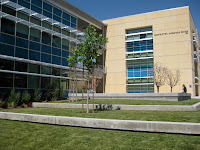
 We decided to spend the rest of the afternoon wandering through the Cal Poly SLO campus where Tim is attending school. Much of the
We decided to spend the rest of the afternoon wandering through the Cal Poly SLO campus where Tim is attending school. Much of the  architecture is postmodern, as can be seen by the photos. One treat was the opportunity to see some early papers by the famed architect, Julia Morgan, designer of the Hearst Castle. The archivist at the Kennedy Library mentioned that Morgan designed the 1925 Monday Club SLO. We were able to capture this beautiful building in the late afternoon light.
architecture is postmodern, as can be seen by the photos. One treat was the opportunity to see some early papers by the famed architect, Julia Morgan, designer of the Hearst Castle. The archivist at the Kennedy Library mentioned that Morgan designed the 1925 Monday Club SLO. We were able to capture this beautiful building in the late afternoon light.
Dinner was at F. McLintocks Saloon, right in downtown. They are best known for their barbecued ribs and tri-tips, but they had a terrific $8 barbecued chicken special that evening. There were so many leftovers that Tim had plenty of food to take home!
Our motel, the Ramada, was conveniently located for exiting SLO the next day. For about $70, it was OK, nothing special. We think we might try a nearby bed and breakfast for a little more money the next time we stay in SLO.
Highway 1, San Simeon to Carmel-by-the-Sea

 Wednesday May 13: We had originally intended to take US 101 to the Monterey area, but the weather forecast was for a fogless day along CA SR 1 (Highway 1), a rare occurrence, so we went for the coastal route. This proved to be providential, as can be seen in the photos! Our first stop was at the Piedras Blancas Elephant Seal Rookery, located about eight miles north of San Simeon. The Rookery is a short distance south of the Piedras Blancas Lighthouse (in the background). There was considerable vocalizing going on as males vied for dominance. May was the molting season, as can be seen in the close up photo.
Wednesday May 13: We had originally intended to take US 101 to the Monterey area, but the weather forecast was for a fogless day along CA SR 1 (Highway 1), a rare occurrence, so we went for the coastal route. This proved to be providential, as can be seen in the photos! Our first stop was at the Piedras Blancas Elephant Seal Rookery, located about eight miles north of San Simeon. The Rookery is a short distance south of the Piedras Blancas Lighthouse (in the background). There was considerable vocalizing going on as males vied for dominance. May was the molting season, as can be seen in the close up photo.
 We
We 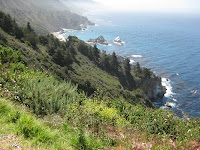
 experienced odd temperature fluctuations as we drove toward Big Sur. This was due to an inversion layer imposed by a strong ridge of high atmospheric pressure. Typical temperatures this mid-morning were around 55°F near sea level, but near 80°F atop the ridgelines around Big Sur. The wildflowers were still spectacular, as can be seen in the view of the historic Big Creek Bridge (upper left photo in the distance).
experienced odd temperature fluctuations as we drove toward Big Sur. This was due to an inversion layer imposed by a strong ridge of high atmospheric pressure. Typical temperatures this mid-morning were around 55°F near sea level, but near 80°F atop the ridgelines around Big Sur. The wildflowers were still spectacular, as can be seen in the view of the historic Big Creek Bridge (upper left photo in the distance).
 We decided to picnic at the Big Sur Station Multi-Agency and Visitor Center, operated by the California Department of Transportation (CalTrans), Los Padres National Forest and California State Parks. As one can see, we were popular with the local denizens!
We decided to picnic at the Big Sur Station Multi-Agency and Visitor Center, operated by the California Department of Transportation (CalTrans), Los Padres National Forest and California State Parks. As one can see, we were popular with the local denizens!

 We devoted the rest of the afternoon, seeing the sights of Carmel-by-the-Sea. First was a stop at Misión de San Carlos Borroméo de Carmelo (Carmel Mission). We think this is one of the most beautiful of the California Missions. Our exercise consisted of walking among the many boutiques and art galleries Carmel is known for.
We devoted the rest of the afternoon, seeing the sights of Carmel-by-the-Sea. First was a stop at Misión de San Carlos Borroméo de Carmelo (Carmel Mission). We think this is one of the most beautiful of the California Missions. Our exercise consisted of walking among the many boutiques and art galleries Carmel is known for.


 The pièce de résistance was a stroll along Scenic Road near sunset. The full sweep of Monterey Bay, framed by the famed cypresses, made for spectacular views. Of the many pricy residences along Scenic Road, perhaps the most iconic was the Frank Lloyd Wright-designed Walker Residence. (We had identified this house as a possible Wright designed building on an earlier trip here; Marie’s Aunt Andrea verified it). The house was built in 1948. Note the graceful outdoor sculpture.
The pièce de résistance was a stroll along Scenic Road near sunset. The full sweep of Monterey Bay, framed by the famed cypresses, made for spectacular views. Of the many pricy residences along Scenic Road, perhaps the most iconic was the Frank Lloyd Wright-designed Walker Residence. (We had identified this house as a possible Wright designed building on an earlier trip here; Marie’s Aunt Andrea verified it). The house was built in 1948. Note the graceful outdoor sculpture.
 After our stroll, we joined Aunt Andrea “Andy” and Uncle Pete at their home for conversation, followed by a delicious seafood pasta dinner.
After our stroll, we joined Aunt Andrea “Andy” and Uncle Pete at their home for conversation, followed by a delicious seafood pasta dinner.
Our overnight stay was at the Carmel Resort Inn, a picturesque place consisting of a cluster of rustic cottages. This is our favorite low-cost place to stay in Carmel. They had a room available for $60, including breakfast. This is a true bargain, considering the location and amenities.
Scotia and Ferndale
Thursday, May 14: The Carmel Resort Inn’s approach to breakfast is unique. Staff delivers a basket of goodies to one’s room. It was quite complete: muffins, juice, fruit and yogurt. We prepared our own coffee using the coffeemaker in our room. Note: the breakfast baskets come around between 8:00 and 8:30 a.m.; this may be a bit late for some. But given today’s schedule, the timing was perfect.
Today’s travel was mostly in transit to points north. On the way, we stopped in Danville, to join fellow Overseas Adventure Travel (OAT) travelers Ray, Virgie, Tom and Marilyn we met on our Japan trip, for lunch. We overnighted with our long time friend George in Santa Rosa, who prepared a delicious pasta dinner for us.



 Friday May 15: We visited the picturesque historic towns of Scotia and Ferndale.
Friday May 15: We visited the picturesque historic towns of Scotia and Ferndale.
Scotia was formerly the quintessential company town. The Pacific Lumber Company (PALCO) built the town during the 1880s. Today, the Town of Scotia LLC owns the entire townsite after the recent reorganization of PALCO into the Humboldt Lumber Company. The lumber mill still operates today, but the town is trying to diversify its economic base. We had a delightful lunch in the Pub, located in the basement of the beautifully restored Scotia Inn. We found out that the new manager is a member of P.E.O., a women’s philanthropic and educational organization dear to Marie and many of her friends. We are determined to stay in the Scotia Inn the next time we wish to explore this beautiful Redwoods area.

 The Scotia Museum was still closed for the season; however, we could see the outdoor displays relating to the old lumber operation.
The Scotia Museum was still closed for the season; however, we could see the outdoor displays relating to the old lumber operation.



 We then took the bucolic Blue
We then took the bucolic Blue  Slide/Grizzly Bluff Road from Rio Dell to Ferndale. We had last visited Ferndale over 40 years ago, so we thought it was time for another visit. Ferndale was, and still is, best known for its beautifully preserved Victorian homes, and restoration efforts were ongoing in the picturesque downtown, despite the Great Recession of 2008-09. Much of the town has been designated a California Historic Landmark and listed on the National Register of Historic Places. Ferndale, once the largest city in Humboldt County, was an important dairying and transportation center until the construction of U.S. 101 took traffic and commerce five miles away.
Slide/Grizzly Bluff Road from Rio Dell to Ferndale. We had last visited Ferndale over 40 years ago, so we thought it was time for another visit. Ferndale was, and still is, best known for its beautifully preserved Victorian homes, and restoration efforts were ongoing in the picturesque downtown, despite the Great Recession of 2008-09. Much of the town has been designated a California Historic Landmark and listed on the National Register of Historic Places. Ferndale, once the largest city in Humboldt County, was an important dairying and transportation center until the construction of U.S. 101 took traffic and commerce five miles away.
We made a stop at one of our favorite cheese shops, Loleta Cheese Factory, to pick up some artisan cheeses and a cheese cutting board for Laurene, then headed to tonight’s destination, Willow Creek.
Willow Creek is located in the heart of Bigfoot Country, where sightings of Bigfoot or Sasquatch were alleged to have occurred. The small Willow Creek-China Flat Museum, also known colloquially as the Bigfoot Museum, was still open this late afternoon, so we paid it a visit. We settled in the Bigfoot Motel ($68), the only AAA-recommended lodging in Willow Creek. It was nothing fancy, nor did it offer breakfast, but it was a comfortable stay. The Pizza Factory, located right across the street, offered $5 specials of spaghetti and “mini” pizzas. These meals were so substantial that we had leftovers we ate for breakfast the next morning!
Highway 96, State of Jefferson Scenic Byway
Saturday May 16: We were looking with great anticipation to today’s drive, that was to take us from Willow Creek and Happy Camp to Cave Junction, OR via the State of Jefferson Scenic Byway. The first segment consisted of CA SR 96 (Highway 96) from Willow Creek to Happy Camp, where we first followed the Trinity River, which joins the Klamath River at Weitchpec.
 Our first stop was the Trinity River Farm, located just outside of Willow Creek. It was only 7:30 a.m. but the kindly owner, Tom O’Gorman met us at the produce stand, and took us around the grounds replete with trees he planted himself. He and Molly O’Gorman have expanded the grounds for weddings and other outdoor events. We bought a six pack of heirloom tomato varieties for Laurene to add to her garden.
Our first stop was the Trinity River Farm, located just outside of Willow Creek. It was only 7:30 a.m. but the kindly owner, Tom O’Gorman met us at the produce stand, and took us around the grounds replete with trees he planted himself. He and Molly O’Gorman have expanded the grounds for weddings and other outdoor events. We bought a six pack of heirloom tomato varieties for Laurene to add to her garden.

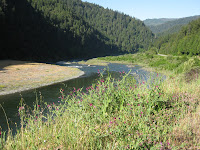
 Note the spectacular scenery along both the Trinity and Klamath Rivers!
Note the spectacular scenery along both the Trinity and Klamath Rivers!
Note: We learned later that the attractive yellow flowering plant next to the Klamath River is a noxious, invasive non-native called Dyer's Woad or Marlahan Mustard (below). See the Redding Record Searchlight article for more information.
We pulled into Happy Camp, fully 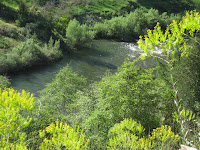

 expecting we would find U.S. Primary Forest Road 48 (aka Indian Creek Road) that would take us to Cave Junction. But this was not to be: heavy rains a week prior washed out this road; it was passable only by high clearance vehicles, which our little Corolla is not! Although Doug was disappointed (Marie was thrilled!), we decided to continue east on Highway 96 to Yreka, Interstate 5 and backtrack a bit to Grants Pass and Wilderville on US 199.
expecting we would find U.S. Primary Forest Road 48 (aka Indian Creek Road) that would take us to Cave Junction. But this was not to be: heavy rains a week prior washed out this road; it was passable only by high clearance vehicles, which our little Corolla is not! Although Doug was disappointed (Marie was thrilled!), we decided to continue east on Highway 96 to Yreka, Interstate 5 and backtrack a bit to Grants Pass and Wilderville on US 199.
There were some hints that we were within the Mythical State of Jefferson: we saw several flags with the Great Seal of the State of Jefferson with two Xs within a circle adorning some historic general stores, and rod and reel places. We learned later that proponents of the State of Jefferson adopted this logo because California and Oregon allegedly doublecrossed the citizenry by failing to provide adequate roads and services to this remote region! See Huell Howser’s recent road trip about the Mythical State of Jefferson, courtesy of PBS TV Station KCET, Los Angeles.
 We came across this historic bridge in Horse Creek, one of many tiny places on the Klamath River.
We came across this historic bridge in Horse Creek, one of many tiny places on the Klamath River.
We made a stop in Medford at a Pilot gas station and truck stop, known for their competitive prices. What a zoo! It seem everybody wanted to refuel this Saturday afternoon. Compounding the situation was the fact that Oregon is one of two states (the other is New Jersey) that still requires station attendants to dispense fuel. This may work fine if one uses a credit or debit card at the pump, but we wanted to use cash. This entailed the attendant giving us a chit that we had to take to the cash register. Then it was a hassle getting back on the freeway, due to traffic gridlock. Geez! We came to Oregon for this? (An aside: an Arco in Grants Pass has the best price in the region, 6 cents a gallon less than the Pilot!)
Fortunately, things were much more tranquil when we reached Laurene and Jim’s home in the woods of Wilderville. We always have a great time visiting with them!
Jim grilled steaks and Laurene prepared the fixings for a hearty delicious meal. Since we don’t eat that much red meat, this was a treat!
It was still balmy after this hot day, so we sat on their porch to watch for bats that zoom among the trees.
Wilderville and Applegate Valley
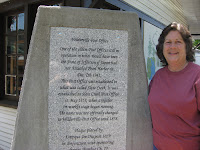

 Sunday, May 17: Yes, there really is a town called Wilderville! At least, there is a general store with lodging on the second floor, and a tiny U.S. Post Office. Here is living proof! According to Joan Momsen’s Wilderville, Oregon History, “the ‘Slate Creek Post Office’ was established on September 30, 1858, but later changed to Wilderville on August 12, 1878. Some say that the post office was named after its postmaster, Joseph Wilder.” Laurene is standing by the historic monument commemorating the Wilderville Post Office; Jim is waiting for us on the front porch. Here is the post office today.
Sunday, May 17: Yes, there really is a town called Wilderville! At least, there is a general store with lodging on the second floor, and a tiny U.S. Post Office. Here is living proof! According to Joan Momsen’s Wilderville, Oregon History, “the ‘Slate Creek Post Office’ was established on September 30, 1858, but later changed to Wilderville on August 12, 1878. Some say that the post office was named after its postmaster, Joseph Wilder.” Laurene is standing by the historic monument commemorating the Wilderville Post Office; Jim is waiting for us on the front porch. Here is the post office today.
 Fish Hatchery Road, on which the Town of Wilderville is located, was an earlier alignment of the Redwood Highway before US 199 was built. We said in an earlier posting that Wilderville is right on US 199; it is true the postal zip code service area straddles US 199 but the post office is located on Fish Hatchery Road. Wilderville was a stagecoach stop on this old road, Crescent City Turnpike and Puncheon (Plank) Road that began in Crescent City, CA and ended in Jacksonville, OR. As far as we could tell, no trace of the old stage stop remains. However, the town had been a hub of stage and railroad transport of resources in the area until the “new” US 199 was constructed.
Fish Hatchery Road, on which the Town of Wilderville is located, was an earlier alignment of the Redwood Highway before US 199 was built. We said in an earlier posting that Wilderville is right on US 199; it is true the postal zip code service area straddles US 199 but the post office is located on Fish Hatchery Road. Wilderville was a stagecoach stop on this old road, Crescent City Turnpike and Puncheon (Plank) Road that began in Crescent City, CA and ended in Jacksonville, OR. As far as we could tell, no trace of the old stage stop remains. However, the town had been a hub of stage and railroad transport of resources in the area until the “new” US 199 was constructed.
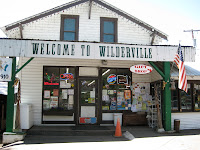
 According to the Highway 199 Road Guide, Crescent City to Grants Pass, the present store is a remnant of the Camp O’ The Woods auto camp that dated back to the 1930s (see Milepost 11.4 in the above link). Do compare the two photos of the store!
According to the Highway 199 Road Guide, Crescent City to Grants Pass, the present store is a remnant of the Camp O’ The Woods auto camp that dated back to the 1930s (see Milepost 11.4 in the above link). Do compare the two photos of the store!
The above source also states that Wilderville’s Lake O’ The Woods was notable for another reason: it was the temporary home of V. T. Hamlin, the peripatetic cartoonist for the Alley Oop comic strip. He and his wife Dorothy lived here at a lodge intermittently on the premises during the 1930s. The inspiration for his caveman characters came in part from the Grants Pass Cavemen, a booster club formed in 1922 to promote the Oregon Caves National Monument. Wilderville was renamed Tamerville in some of his strips!
Still another interesting story was that of the California and Oregon Coast Railroad (C&OCRR) that was supposed to link Grants Pass with Crescent City. See the interesting narrative, courtesy of the Short Lines Railroad Web site, featuring a monograph by the Josephine County Historical Society. The C&OCRR was conceived as a short line railroad shipping line intended to undercut the high cost Southern Pacific Railroad. However, only the segment from Grants Pass to Wonder, about three miles west of Wilderville was ever completed. Financial and terrestrial obstacles were too daunting to surmount, to complete the line to the coast. However, traces of the old rail bed can still be seen today in Wilderville.

 Slate Creek borders the Wilderville Store on the south, creating a lovely garden setting.
Slate Creek borders the Wilderville Store on the south, creating a lovely garden setting.

 We spent this warm Sunday with Laurene and Jim exploring the Wilderville area and Applegate Valley. Marie and Laurene are plant people, so we visited a lovely nursery in the nearby hamlet of Murphy, another spot on Fish Hatchery Road. We had time to visit one winery on the Applegate Wine Trail-Soloro Vineyard. We took home a delicious Syrah and Grenache. We learned later that we got in on a spring barrel tasting event paired with food. The Navarro’s file gumbo was a standout, according to a review in the Southern Oregon MailTribune.
We spent this warm Sunday with Laurene and Jim exploring the Wilderville area and Applegate Valley. Marie and Laurene are plant people, so we visited a lovely nursery in the nearby hamlet of Murphy, another spot on Fish Hatchery Road. We had time to visit one winery on the Applegate Wine Trail-Soloro Vineyard. We took home a delicious Syrah and Grenache. We learned later that we got in on a spring barrel tasting event paired with food. The Navarro’s file gumbo was a standout, according to a review in the Southern Oregon MailTribune.
We treated Laurene and Jim to a buffet dinner at J.J. North’s Grand Buffet, a short distance away in Grants Pass. At about $10 a person, we felt it offered great value!
Highway 3, Trinity Alps Trail, Yreka, Weaverville and Shasta
 Monday, May 18: We got off to an early start, because our goal today was to explore another scenic byway, CA SR 3 (Highway 3) that connects Yreka with Weaverville through the spectacular Trinity Alps, then continue east on CA SR 299 (Highway 299) to Redding and points south. Here is a photo of the Klamath River just before the Yreka turnoff.
Monday, May 18: We got off to an early start, because our goal today was to explore another scenic byway, CA SR 3 (Highway 3) that connects Yreka with Weaverville through the spectacular Trinity Alps, then continue east on CA SR 299 (Highway 299) to Redding and points south. Here is a photo of the Klamath River just before the Yreka turnoff.
We explored Yreka, seat of Siskiyou County and the proposed capital of the State of Jefferson. A major attraction is the Million Dollar Gold Display in the lobby of the 1950s-style Siskiyou County Courthouse. One cannot blame the authorities for the heavy security here! According to the Visit Siskiyou Web site, “[this is] the largest gold display south of Alaska. The interpretive display is arranged according to the site from which the gold was taken, and includes old photos, descriptions and recollections of the miners. On display are the many forms of gold found in the area, including huge nuggets, flour gold and gold dust.”



 We continued exploring downtown Yreka on foot, still seeking vestiges of the mythical State of Jefferson, and found this tee shirt on display at a hardware store. Historic preservation was going strongly in Yreka, as can be seen in the photos. We also found this unusual sepia-toned mural depicting Yreka's early history.
We continued exploring downtown Yreka on foot, still seeking vestiges of the mythical State of Jefferson, and found this tee shirt on display at a hardware store. Historic preservation was going strongly in Yreka, as can be seen in the photos. We also found this unusual sepia-toned mural depicting Yreka's early history.

 The drive south on Highway 3 through Scott Valley and the Trinity Alps was spectacularly beautiful, and we would recommend it highly. The villages of Fort Jones and Etna had some interesting historic buildings and are worth further exploration.
The drive south on Highway 3 through Scott Valley and the Trinity Alps was spectacularly beautiful, and we would recommend it highly. The villages of Fort Jones and Etna had some interesting historic buildings and are worth further exploration.
We had a picnic lunch  at Trinity Lake, much diminished by drought. At least it was a cool, shady spot on what was proving to be an unusually hot day.
at Trinity Lake, much diminished by drought. At least it was a cool, shady spot on what was proving to be an unusually hot day.
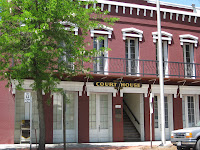


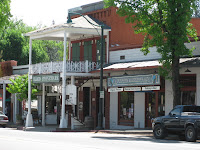
 Weaverville is the seat of Trinity County and we spent a couple of hours exploring it. The 1857 Trinity County Courthouse is still in use today and among the oldest in the state (Mariposa’s Mariposa County Courthouse, built in 1854, is reputed to be the oldest).
Weaverville is the seat of Trinity County and we spent a couple of hours exploring it. The 1857 Trinity County Courthouse is still in use today and among the oldest in the state (Mariposa’s Mariposa County Courthouse, built in 1854, is reputed to be the oldest).


 We walked through the tranquil grounds of the Weaverville Joss House State Historic Park, site of the oldest wooden Chinese temple still in use in California. Unfortunately, this Taoist temple was closed today, but a state park ranger was on hand to provide us with some background.
We walked through the tranquil grounds of the Weaverville Joss House State Historic Park, site of the oldest wooden Chinese temple still in use in California. Unfortunately, this Taoist temple was closed today, but a state park ranger was on hand to provide us with some background.
 We finished our Weaverville visit at the Jake Jackson Memorial Museum, which provided a good overview of Trinity County’s history.
We finished our Weaverville visit at the Jake Jackson Memorial Museum, which provided a good overview of Trinity County’s history.

 Next, we headed east on Highway 299. Our first scheduled stop was the ghost town of Shasta, now a State Historic Park. It dates to around 1861, and
Next, we headed east on Highway 299. Our first scheduled stop was the ghost town of Shasta, now a State Historic Park. It dates to around 1861, and  was a former county seat. The former courthouse (closed Mondays) houses a museum. Some of the old buildings have been restored and are home to tourist-oriented establishments.
was a former county seat. The former courthouse (closed Mondays) houses a museum. Some of the old buildings have been restored and are home to tourist-oriented establishments.
Our stimulus money at work: We had numerous delays on Highway 299 for roadwork. Time and again, we would see those dreaded tangerine signs warning of “ROAD WORK AHEAD” and “PREPARE TO STOP.” Fortunately we were not on a schedule.
When we reached Interstate 5 at last, we decided to make Corning our overnight stop. We decided to try an Econolodge with a $38 coupon. Although these kinds of deals can be risky, this one turned out OK. Corning is a major production center for olives, and it was fun visiting the Corning Olive Oil Company . For dinner, we decided to go Mexican this evening; the Casa Ramos in an adjacent Safeway shopping center filled the bill nicely! Not only were the meals tasty but bountiful; we left with two people boxes of food!
Historic Towns, Oroville to Woodland
Tuesday, May 19: The continental breakfast at the Econolodge surprised us with tasty muffins, coffee and orange juice; given the price of the room, this was one great bargain.

 We strung together a series of historic towns to visit on our way to Davis. First was Oroville, the seat of Butte County. We were too early to visit one noteworthy attraction, the Lott Home Museum in Sank Park; however, its lovely Victorian garden was open for a stroll.
We strung together a series of historic towns to visit on our way to Davis. First was Oroville, the seat of Butte County. We were too early to visit one noteworthy attraction, the Lott Home Museum in Sank Park; however, its lovely Victorian garden was open for a stroll.

 We certainly lucked out with the Oroville Chinese Temple and Museum. Although it was not supposed to be open until noon, we were
We certainly lucked out with the Oroville Chinese Temple and Museum. Although it was not supposed to be open until noon, we were 

 able to latch onto a special morning tour with an Asian group from Berkeley. The docent conducted a very thorough description of the Temple’s
able to latch onto a special morning tour with an Asian group from Berkeley. The docent conducted a very thorough description of the Temple’s 
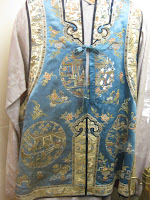

 history, and guided us through the marvelous Tapestry Hall. We could have spent hours here.
history, and guided us through the marvelous Tapestry Hall. We could have spent hours here.
 Before leaving Oroville, we photographed one of several murals, a fairly recent addition to the cityscape.
Before leaving Oroville, we photographed one of several murals, a fairly recent addition to the cityscape.
The CA SR 70 (Highway 70) Freeway became a pleasant rural road as we headed south through the fertile Feather River floodplain.

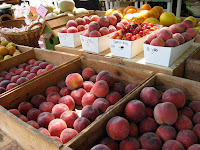 We had a hankering for fresh fruits, so we stopped off at several fruit stands. The largest and most fun was Tony’s Farm Stand, located just north of Marysville. There had a marvelous selection of fresh peaches and cherries, which were great supplements to our picnics down the line.
We had a hankering for fresh fruits, so we stopped off at several fruit stands. The largest and most fun was Tony’s Farm Stand, located just north of Marysville. There had a marvelous selection of fresh peaches and cherries, which were great supplements to our picnics down the line.
We headed for the twin cities of Marysville, seat of Yuba County, and Yuba City, seat of Sutter County (got that?) A good resource for learning about the sights in Yuba and Sutter Counties is the Visit Yuba-Sutter Web site.
 Marysville was a walkable town, with a well-restored central business district centered on “D” Street. We found this mural of "Old Marysville", painted on the side of a commercial building.
Marysville was a walkable town, with a well-restored central business district centered on “D” Street. We found this mural of "Old Marysville", painted on the side of a commercial building.
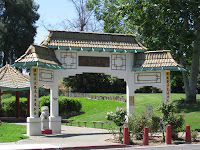
 At the south end of downtown, next to the levee, was the Bok Kai Chinese Temple, which dates from 1880. This further
At the south end of downtown, next to the levee, was the Bok Kai Chinese Temple, which dates from 1880. This further  demonstrated how important the Chinese were in the exploitation of the goldfields.
demonstrated how important the Chinese were in the exploitation of the goldfields.

 We crossed the Feather River to Yuba City, to seek out the historic Sutter County Courthouse and Hall of Records. After a picnic at the new (2008) Gauche Aquatic Park, a cool oasis on this hot day, we made our way to Second Street. The Sutter County Courthouse, a Classical Revival structure circa 1899, and the Sutter County Hall of Records, built in Richardsonian Romanesque style in 1891, dominate the Second Street District of historic buildings. Graceful Victorians in the neighborhood reflect Italianate, Classical and Eastlake influences.
We crossed the Feather River to Yuba City, to seek out the historic Sutter County Courthouse and Hall of Records. After a picnic at the new (2008) Gauche Aquatic Park, a cool oasis on this hot day, we made our way to Second Street. The Sutter County Courthouse, a Classical Revival structure circa 1899, and the Sutter County Hall of Records, built in Richardsonian Romanesque style in 1891, dominate the Second Street District of historic buildings. Graceful Victorians in the neighborhood reflect Italianate, Classical and Eastlake influences.
Note: Marysville did a great job in identifying its historical sites and districts, and it was easy to find things. Yuba City lacks such signage on the ground; we recommend printing out maps from the Visit Yuba-Sutter Web site, which we failed to do!


 The final historic town for today was Woodland, seat of Yolo County. We decided to abandon the major highway system, and take CA SR 113 (Highway 113) to Woodland, ending at today’s destination, Davis. As we crossed the Yolo County Line, there was evidence of another stimulus “shovel-ready” project: the dreaded ROAD WORK and PREPARE TO STOP signs appeared again! It wasn’t too long a wait, though, and the flagger flashed a friendly smile as we passed her SLOW sign.
The final historic town for today was Woodland, seat of Yolo County. We decided to abandon the major highway system, and take CA SR 113 (Highway 113) to Woodland, ending at today’s destination, Davis. As we crossed the Yolo County Line, there was evidence of another stimulus “shovel-ready” project: the dreaded ROAD WORK and PREPARE TO STOP signs appeared again! It wasn’t too long a wait, though, and the flagger flashed a friendly smile as we passed her SLOW sign.

 We found Woodland to be an extremely pleasant town to stroll about. Tuesday is the best day to visit Woodland, because this is the one day a week the 1895 Woodland Opera House Theatre is open for guided tours. It is a working theatre that has undergone a meticulous restoration. The docent was a delightful grandmotherly lady, a San Diego native no less, who gave us a tour into the deepest recesses of the place.
We found Woodland to be an extremely pleasant town to stroll about. Tuesday is the best day to visit Woodland, because this is the one day a week the 1895 Woodland Opera House Theatre is open for guided tours. It is a working theatre that has undergone a meticulous restoration. The docent was a delightful grandmotherly lady, a San Diego native no less, who gave us a tour into the deepest recesses of the place.

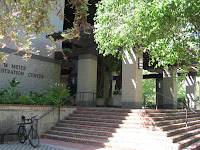 The 1917 Yolo County Courthouse is a courtly neoclassical edifice, one of the handsomest in California, in our opinion. It is listed on the National Register of Historic Places. Although it is still in use as a courthouse today, we understand that it will soon be vacated and made available for adaptive reuse. The adjacent Meier County Administration Center is a tastefully-designed modern building that complements the older structure.
The 1917 Yolo County Courthouse is a courtly neoclassical edifice, one of the handsomest in California, in our opinion. It is listed on the National Register of Historic Places. Although it is still in use as a courthouse today, we understand that it will soon be vacated and made available for adaptive reuse. The adjacent Meier County Administration Center is a tastefully-designed modern building that complements the older structure.
After Woodland, it was time to head to Davis. We stopped in at the Best Western University Lodge, located about two blocks from the UC Davis campus. Although relatively expensive at $90 AAA a night, it was within easy walking distance of the campus and other attractions we were interested in. We finished off our leftovers from the Mexican restaurant in Corning, supplemented by the fresh fruit we bought today.
The balmy evening was conducive to walking about the eclectic neighborhood comprising student oriented businesses, Greek houses (some well kept, others unkempt), and a mixture of single-family residences and apartments. Cheap beer was abundant, typically priced during happy hour at $2.50 a pint. The bicycle is the principal means of transportation around town and the campus; where bike and pedestrian paths were not separated, we had to be on the lookout for “killer bikes”! The Borders store and adjacent restaurant, magnets for students and professors alike, were busy late into the evening.
After catching up on our e-mails on the motel’s painfully slow public computer (it must have been on a dialup internet service), we turned in.
Davis, University Town
Wednesday, May 20: A segment of Huell Howser’s Road Trip series inspired us to spend the day on the UC Davis campus.
The Best Western offered a generous continental breakfast, which gave us a good start to the day. We were only a couple of city blocks to the southerly pedestrian gateway to the campus.
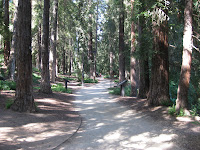


 As we were expecting another hot day, we began with a stroll through the Arboretum. This is a peaceful linear park created from the bed of Putah Creek that borders the campus. As we walked along, we realized the Arboretum is much more than a park; it is a teaching tool for sustainable and environmentally friendly planting practices as well as a place to escape from hectic campus life.
As we were expecting another hot day, we began with a stroll through the Arboretum. This is a peaceful linear park created from the bed of Putah Creek that borders the campus. As we walked along, we realized the Arboretum is much more than a park; it is a teaching tool for sustainable and environmentally friendly planting practices as well as a place to escape from hectic campus life.
There are several small museums and galleries open to the public, but their hours are limited and the Richard L. Nelson Gallery and Fine Arts Collection was closed for a new installation.
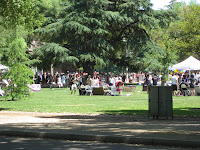 The other exhibits we wanted to visit were only open at noon, so we decided to have lunch in the bustling Student Coffee House, where salads are sold for 34 cents an ounce! (2009 prices). We then treated ourselves to $1 scoops of the sinful Blue Bell chocolate ice cream, a real treat! Note the lunch crowd enjoying the outdoors.
The other exhibits we wanted to visit were only open at noon, so we decided to have lunch in the bustling Student Coffee House, where salads are sold for 34 cents an ounce! (2009 prices). We then treated ourselves to $1 scoops of the sinful Blue Bell chocolate ice cream, a real treat! Note the lunch crowd enjoying the outdoors.
 Following lunch, we enjoyed the unusual Native-American and indigenous photography exhibit at the Gorman Museum of Native American Art, located in George Hart Hall.
Following lunch, we enjoyed the unusual Native-American and indigenous photography exhibit at the Gorman Museum of Native American Art, located in George Hart Hall.
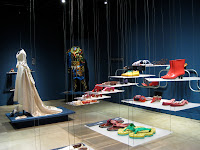 Another interesting attraction was the footwear exhibit in the Design Museum, located in the School of Design Building.
Another interesting attraction was the footwear exhibit in the Design Museum, located in the School of Design Building.
We saved the agriculturally-oriented exhibits for last. The Bohart Museum of Entomology houses over 7 million specimens of interest to the serious bug researcher.

 Several greenhouses are also open to the public. Marie especially enjoyed seeing the unusual orchid specimens on display there.
Several greenhouses are also open to the public. Marie especially enjoyed seeing the unusual orchid specimens on display there.
It was about 3:00 p.m. when we left the campus, to head over to Central Park, site of the Farmer’s Market. We had just enough time to visit the Hattie Weber Museum of Davis, located in a former library building that dates to 1911. We engaged the volunteer on duty in conversation. He was Dr. Dennis Dingemans, Ph.D. (Berkeley), a professor emeritus of geography, who had retired recently from the Geography Department at UC Davis. He knew many of the geography faculty members at UCLA and San Diego State, where Doug attended. We told him about our travel blog, and promised to let him know when we publish the postings of this trip!

 We had purposely scheduled this campus visit on a Wednesday, to enable us to experience the Davis Farmers Market and Picnic in the Park this afternoon and evening. This turned out to be fun, and we would recommend this Farmers Market highly. Note: the Wednesday Market runs only from Mid-March to the end of October most years; they have a morning Saturday Market year round).
We had purposely scheduled this campus visit on a Wednesday, to enable us to experience the Davis Farmers Market and Picnic in the Park this afternoon and evening. This turned out to be fun, and we would recommend this Farmers Market highly. Note: the Wednesday Market runs only from Mid-March to the end of October most years; they have a morning Saturday Market year round).
We shopped for some artisan breads and more fresh fruits (all organically grown) under the large canopies set up for the market. For dinner, we decided to share a huge platter of "Tibetan" (really Northern Indian curries, nan brad, etc) we bought in the international bazaar. On the way back to our room, we stopped off at one of the beer joints for the 2 pints for $5 special. They had a good hefeweizen on tap; at a pint for $2.50 each; this was quite a steal.
An aside: Although we are at least two generations older that most of the students at both Cal Poly SLO and UC Davis, we found it exhilarating to interact with these enthusiastic young people on both campuses. We always found them most helpful when we asked them for directions, etc. Given the depressed job market in 2009, they had real challenges ahead. It was encouraging to see that both campuses emphasize green technology and sustainability that bode well for the future.
Hanford, Then and Now
Thursday, May 21: This was a major travel day so we limited our sight-seeing to another of Huell Howser’s Road Trip gems-Hanford, the seat of Kings County, plus nearby Lemoore. We stayed on CA SR 99 (Highway 99) until Fresno, where we turned off on CA SR 41 (Highway 41) to Lemoore. This good highway took us to a point just east of the Lemoore Naval Air Station (NAS Lemoore).
We headed east on Bush Road, with a quick left turn onto D Street that took us through the heart of Lemoore’s Historic Downtown. Like Hanford, Lemoore has a vibrant historic preservation effort underway. We suspect this town is relatively prosperous due to the presence of NAS Lemoore.
 Hanford’s Courthouse Square was the focus of today’s sightseeing and we timed it for early afternoon. First was the Old Kings County Courthouse, built in 1896 (expanded 1914) in Neo-Classical style. It ceased being used as a courthouse in 1979 and is now leased for offices and restaurants. Another significant building on Courthouse Square is the former Sheriff’s Office and Jail (known as “The Bastille”) for its massive Richardsonian Romanesque architecture as well as its history as a prison. The Bastille has been converted to restaurant space.
Hanford’s Courthouse Square was the focus of today’s sightseeing and we timed it for early afternoon. First was the Old Kings County Courthouse, built in 1896 (expanded 1914) in Neo-Classical style. It ceased being used as a courthouse in 1979 and is now leased for offices and restaurants. Another significant building on Courthouse Square is the former Sheriff’s Office and Jail (known as “The Bastille”) for its massive Richardsonian Romanesque architecture as well as its history as a prison. The Bastille has been converted to restaurant space.
 Hanford has made a real effort to teach schoolchildren local history and make it fun and entertaining at the same time. Two vintage fire engines, sirens wailing, loaded with screaming kids, pulled up to the 1939 Allan Herschell Carousel, located on the Courthouse grounds. We understand the carousel was salvaged from a park in Visalia, and installed here in 1985. Its latest restoration occurred early in 2009.
Hanford has made a real effort to teach schoolchildren local history and make it fun and entertaining at the same time. Two vintage fire engines, sirens wailing, loaded with screaming kids, pulled up to the 1939 Allan Herschell Carousel, located on the Courthouse grounds. We understand the carousel was salvaged from a park in Visalia, and installed here in 1985. Its latest restoration occurred early in 2009.
After a picnic lunch on Courthouse Square, we yielded to temptation (again) and walked across the street to the 1929 Superior Dairy Products Company, featured in Huell Howser’s piece on Hanford. We walked to the back of the store, where we had a huge single scoop each of chocolate ice cream. We marveled how some people could manage the truly humongous sundaes sold there!

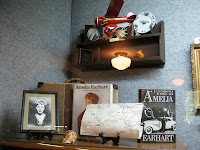
 Now re-energized, we visited the nearby Hanford Carnegie Museum, built in 1905 as one of the many libraries funded by Andrew Carnegie throughout the nation. It is an exquisite example of Richardsonian Romanesque architecture. One of the most interesting exhibits was the Amelia Earhart display, mainly dealing with her involvement in the fashion outer wear industry.
Now re-energized, we visited the nearby Hanford Carnegie Museum, built in 1905 as one of the many libraries funded by Andrew Carnegie throughout the nation. It is an exquisite example of Richardsonian Romanesque architecture. One of the most interesting exhibits was the Amelia Earhart display, mainly dealing with her involvement in the fashion outer wear industry.
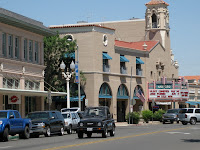
 Other historical buildings border on Courthouse Square. First was the spectacularly restored 1929 Hanford Fox Theatre. It is in use today as a venue for plays and musical acts as well as movies. It employs green technology as it now uses electricity produced by solar panels! The magnificent Hanford Civic Auditorium was built in 1924 and is still in use today.
Other historical buildings border on Courthouse Square. First was the spectacularly restored 1929 Hanford Fox Theatre. It is in use today as a venue for plays and musical acts as well as movies. It employs green technology as it now uses electricity produced by solar panels! The magnificent Hanford Civic Auditorium was built in 1924 and is still in use today.
 We drove to China Alley (it was simply too hot for walking any distance). The centerpiece is the 1886 Hanford Taoist Temple and Museum, which was closed today. It seemed to us this once vibrant Chinatown is being encroached upon by the mostly Hispanic neighborhood (we heard nothing but Mexican banda music while we were strolling down this historic alley).
We drove to China Alley (it was simply too hot for walking any distance). The centerpiece is the 1886 Hanford Taoist Temple and Museum, which was closed today. It seemed to us this once vibrant Chinatown is being encroached upon by the mostly Hispanic neighborhood (we heard nothing but Mexican banda music while we were strolling down this historic alley).


 There was one more must see attraction before leaving the Hanford area. This was the Clark Center for Japanese Art and Culture, located about six miles south of town. This is an amazing facility, located in a farming area. It reminded us of Japan in miniature! We went into the office, expecting to pay the $5 admission, because the Web site indicated it was open today. Turned out that the exhibit space was closed for a new installation!
There was one more must see attraction before leaving the Hanford area. This was the Clark Center for Japanese Art and Culture, located about six miles south of town. This is an amazing facility, located in a farming area. It reminded us of Japan in miniature! We went into the office, expecting to pay the $5 admission, because the Web site indicated it was open today. Turned out that the exhibit space was closed for a new installation!
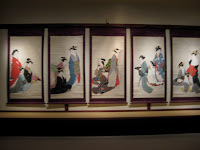

 We pleaded our case that we were from out of town and we had heard such good things about the Clark Center. Finally, the manager relented and a pleasant young lady, an art intern from Germany, took us around. There was plenty of the permanent collection on view, including tapestries and wall screens, as can be seen in the photos. We thanked her profusely for accommodating us. Word of advice: call ahead, to be sure they are open; they have a good Web site, but the posted hours may not be fully reliable.
We pleaded our case that we were from out of town and we had heard such good things about the Clark Center. Finally, the manager relented and a pleasant young lady, an art intern from Germany, took us around. There was plenty of the permanent collection on view, including tapestries and wall screens, as can be seen in the photos. We thanked her profusely for accommodating us. Word of advice: call ahead, to be sure they are open; they have a good Web site, but the posted hours may not be fully reliable.


 The gardens at the Clark Center are pleasant to stroll about; note the Zen rock garden and water feature.
The gardens at the Clark Center are pleasant to stroll about; note the Zen rock garden and water feature.
It was now time to find a place to stay. We decided on Bakersfield, since we wanted to arrive in Pasadena the next day in mid-morning. We cut across on CA SR 137 (Highway 137) through Tulare to Highway 99 and headed south. Marie perused the coupon books, and we decided to take a chance on the Vagabond in North Bakersfield for about $40. Sorry to say, we did not fare too well. The room was nice enough, but the traffic noise on adjacent Highway 99 was atrocious! We believe this large motel was of 1960s vintage, with little in the way of noise suppression. The roar of truck traffic diminished only slightly so we got little sleep that night. Augh!
Pasadena, Then Home
Friday, May 22: The one good feature of the continental breakfast at the Vagabond was the waffle iron, the kind that rotates to cook, and timed to turn out a perfect Belgian waffle in 2 minutes, 50 seconds. We took a little time to show a couple from Germany how to operate it.
Otherwise, the Vagabond offered only high sugar doughnuts and pastries. The orange juice machine was on the fritz and they were running out of coffee. Needless to say, we will not stay in this place again and we sent a complaint letter to Vagabond headquarters. Oh well!
 We headed to Pasadena to visit Doug’s cousin, Linda, which we try to do during our trips north. She lives in a pleasant apartment complex in a leafy neighborhood just west of the Cal Tech campus. The nearby Baja Fresh Restaurant is one of her favorite places and we were enjoying lunch there.
We headed to Pasadena to visit Doug’s cousin, Linda, which we try to do during our trips north. She lives in a pleasant apartment complex in a leafy neighborhood just west of the Cal Tech campus. The nearby Baja Fresh Restaurant is one of her favorite places and we were enjoying lunch there.
We expected heavy traffic on the I-405, since this was get-a-way Friday for the Memorial Holiday Weekend. We avoided much of the traffic congestion by heading east on I-210 to I-15, then home. It took us about three hours from Pasadena.
Total mileage was about 2,600 miles, and a very pleasant trip indeed!
 Fish Hatchery Road, on which the Town of Wilderville is located, was an earlier alignment of the Redwood Highway before US 199 was built. We said in an earlier posting that Wilderville is right on US 199; it is true the postal zip code service area straddles US 199 but the post office is located on Fish Hatchery Road. Wilderville was a stagecoach stop on this old road, Crescent City Turnpike and Puncheon (Plank) Road that began in Crescent City, CA and ended in Jacksonville, OR. As far as we could tell, no trace of the old stage stop remains. However, the town had been a hub of stage and railroad transport of resources in the area until the “new” US 199 was constructed.
Fish Hatchery Road, on which the Town of Wilderville is located, was an earlier alignment of the Redwood Highway before US 199 was built. We said in an earlier posting that Wilderville is right on US 199; it is true the postal zip code service area straddles US 199 but the post office is located on Fish Hatchery Road. Wilderville was a stagecoach stop on this old road, Crescent City Turnpike and Puncheon (Plank) Road that began in Crescent City, CA and ended in Jacksonville, OR. As far as we could tell, no trace of the old stage stop remains. However, the town had been a hub of stage and railroad transport of resources in the area until the “new” US 199 was constructed.